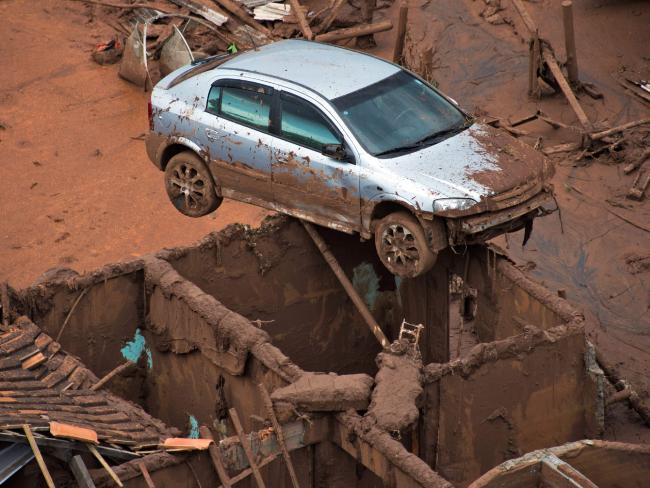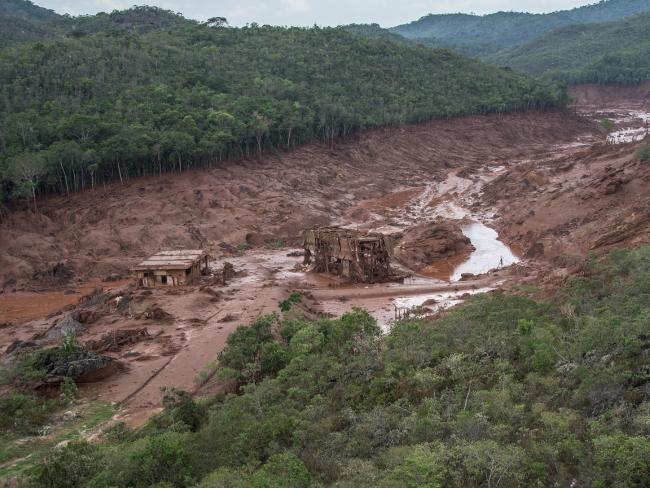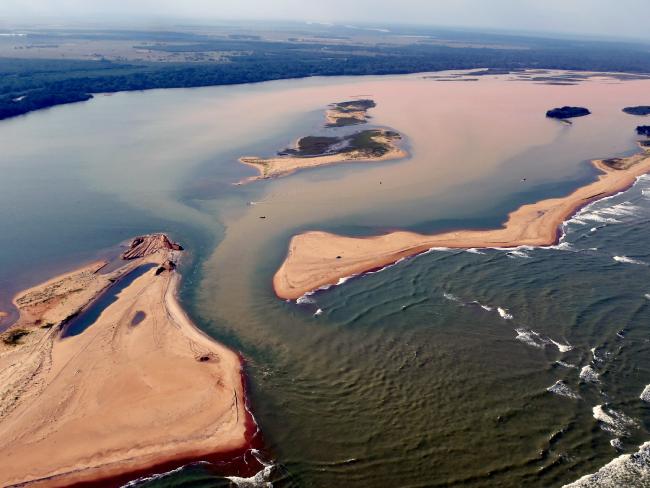
Damage caused in Bento Rodrigues, Mariana district of Minas Gerais, southeastern Brazil, which was hit by mining waste after Samarco company's dam break on 6 November 2015. Picture: Marcio Fernandes/Estadao Conteudo/AFP
IT TOOK decades to build and just minutes to completely destroy.
This is what remains of Bento Rodrigues, the small Brazilian village that was flattened by a 20m wall of toxic mud that spewed out of a burst tailings dam from a nearby mine site in the Mariana region of Minas Gerais in the south east of the country.
An estimated 40-60 million cubic metres of thick sludge swept through, without warning, swallowing just about everything in its path.
Residents, who had lived in the shadow of the Samarco Mineiracoes mine, a joint venture between Vale SA and the Australian-owned BHP Billiton for the past decade, reportedly had just 25 minutes to flee for their lives.
Despite reports revealing the plant’s operator knew of the leak 10 hours earlier, locals were not told and had to fend for themselves when the monster wave came hurtling towards their village on November 5, 2015.
Hundreds were displaced, dozens injured and 19 people were killed in what has been described as Brazil’s biggest environmental catastrophe.
But the devastation caused by the Samarco Mineiracoes mine disaster is not limited to the immediate destruction of Bento Rodrigues.
The effects of the spill, which pumped contaminated mud all the way out to the Atlantic Ocean in the space of three weeks, will be felt for years to come.

This car is perched on top of what was a house. Picture: Christophe Simon/AFPSource:AFP
Six other areas were hit by the flood. The town of Paracatu was also wiped out, while Governador Valadares, a city of 278,000 people which sits downstream from the mine site, has been struggling with the affects to the Doce River, the biggest casualty of the spill.
Freshwater no longer runs along this vital river’s 600km course.
Instead orangey-red watery-mud runs through its veins, all the way to the Atlantic Ocean.
This has worried experts who fear the damage from the spill will take decades to overcome.
The Doce River was the lifeblood of the region. It supplied the villages and cities along its route with precious water, flora and fauna and jobs for those working in the fishing industry.
Today, three months after the spill, it’s still leaching into the sea prompting more fears it will start to kill marine life such as dolphins, turtles and whales.
The United Nations Human Rights Working Group, which visited the area in the aftermath, described the situation as a “major social and environmental crisis” and called on the companies, as well as the state and federal governments in Brazil to increase efforts to clean up the toxic mess.
Since the dam burst, Samarco, and its owners, Vale SA and BHP Billiton, said they have managed to contain around 85 per cent of the tailings, and are working hard to prevent further tailings from entering the Doce River system.
Dikes were being built to prevent further leaching into the river, and fish had been detected in unaffected tributaries, The Australian reported.
“Further independent analysis of the river by Brazilian Geological Service and the National Water Agency also supported earlier assessments that the tailings material released was non-toxic,’’ BHP Billiton reportedly said in a statement.

The whole village of Bento Rodrigues was wiped out in minutes. Picture: Christophe Simon/AFPSource:AFP
The contaminated mud, when first tested by water management authorities, was found to contain toxic substances like mercury, arsenic, chromium and manganese at levels exceeding human consumption levels, the BBC reported.
As a result, residents such as those in Governador Valadares feared the water was unsafe, despite claims by the mining giants that the dead fish floating in the river were the result of suffocation from mud becoming stuck in their gills.
“There are a lot of rumours that the water is contaminated,” Érico Netto, a 41-year-old doctor in the city, told The Guardian. “I’m drinking mineral water for now.”
In a statement to news.com.au, a spokesman from BHP Billiton said reports it had received from the companies responsible for water supply in the affected areas along the Rio Doce confirmed water treatment facilities were “operational and capable of treating water for human consumption and industrial and agricultural use”.
But it is more the effects the mud will have on flora and fauna that has experts very concerned.
Andres Ruchi, director of the Marine Biology school in Santa Cruz in Espirito Santo, believes the mud could have a devastating impact on marine life when it reaches the sea.
“The flow of nutrients in the whole food chain in a third of the southeastern region of Brazil and half of the Southern Atlantic will be compromised for a minimum of a 100 years,” he told the BBC.
But the full extent of the environmental damage will not be known for some time. And a full environmental assessment by independent contractors has yet to be made, DW.com reported.
Despite the assurances of an independent review, Brazilians remain sceptical.
Over the past 20 years there have been at least four smaller scale mining incidents yet Brazilian authorities have been lax in enforcing its environmental laws.
It is estimated there are around 750 dams just in the Minas Gerais region, 40 of which are considered at risk.
Adding to the anger of the disaster is revelations last month that the iron ore giant knew the dam had problems.

Handout picture released on November 23, 2015 by Espirito Santo State Press Office showing an aerial view of the Rio Doce. Picture: Fred Loureiro/Espirito Santo State Press Office/AFPSource:AFP
According to reports, Samarco Minerals SA received serious danger warnings from ground sensors in 2014 and 2015, months before the incident, the ABC reported.
The alerts, from probes driven deep into the dam’s structure to detect ground moisture and stability, reached as high as “emergency” levels, according to the reports.
Dante Pesce, from the UN business and human rights commission, said when it came to big projects in Brazil, economic value trumped social and environmental concerns, and that fines for bad practices were relatively light.
“Even if the evidence is clear to condemn corporate practices, the fines are very low — and therefore, there is an incentive to take more risks on board than you should,” he told DW.com.
Initially, the Brazilian government fined Samarco 250 million Reals ($91 million) and suspended it from operating.
The Brazilian courts then froze its domestically held assets after the Brazilian government decided to sue Samarco, and its owners Vale SA and BHP Billiton for $7.1 billion.
The public lawsuit, launched in December, requires Samarco to clean up the disaster immediately and seeks a private fund to be set up and administered independently over 10 years for environmental recovery and compensation.
The legal battle is still being played out in the courts but it is not the only one the companies are facing.
Samarco, Vale and seven of their executives have been indicted for environmental crimes by the Brazilian federal police. Charges have not been filed against BHP Billiton.
If found guilty of these crimes, individuals could face up to four years in a Brazilian jail.
Deepwater Disaster - The Untold Story51:57

Engineers and oil men at the heart of the operation tell the untold story of the 87-day battle to kill the Deepwater Horizon oil blowout a mile beneath the waves - a crisis that became America's worst environmental disaster.








